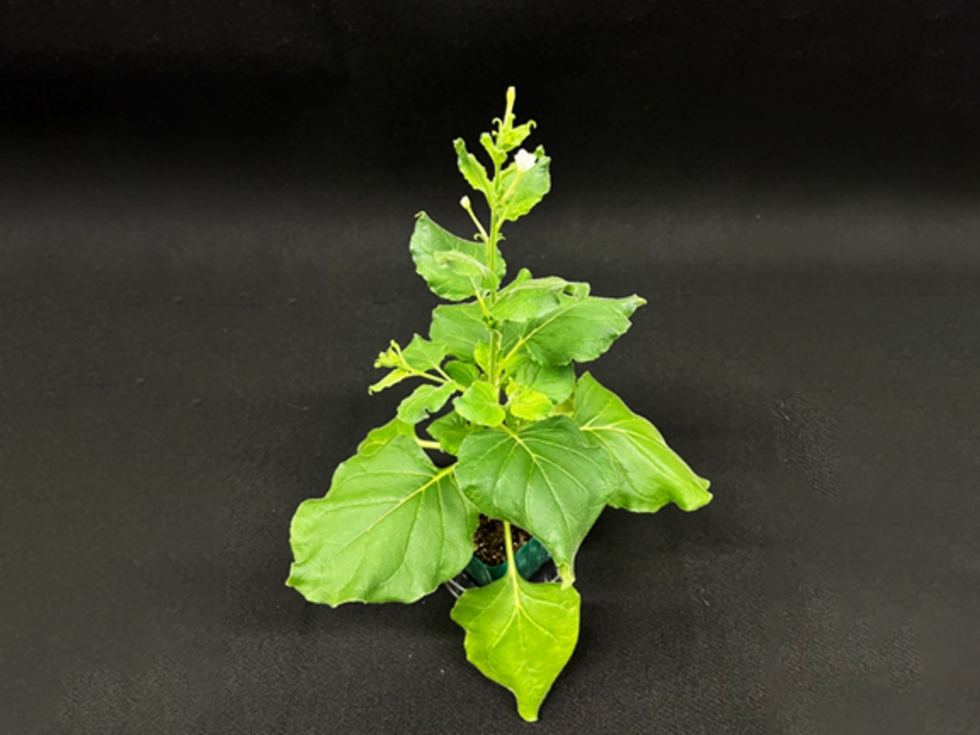
Biology
February 10, 2023
Researchers decode 95.6% of the genome of Nicotiana benthamiana
The plant Nicotiana benthamiana, from the Solanaceae family, is one of the most widely used experimental models in plant science. In 2020, a research group at Nagoya University in Japan reported that N. benthamiana could be grafted with plants from different families, demonstrating a rare ability that many researchers thought impossible. Now, the same research group has used next-generation sequencing technology to decode all the genes in the N. benthamiana tobacco plant genome. Their findings provide insight into how plants are able to perform this grafting. Their results were published in Plant and Cell Physiology.
The genome structure of N. benthamiana has long been a mystery. Its complex genome emerged due to hybridization, meaning its chromosomes are derived from two species of plants. The hybridization event happened approximately 10 million years ago between two closely related plant species: paternal Sylvestres and maternal Tomentosae. To further complicate matters, it continued to evolve through several hybridization events.
Since the genome of plants, such as N. benthamiana, is so large, researchers struggle to analyze it in its entirety using current technology. Therefore, to study it more effectively, scientists cut it into smaller fragments for sequencing, creating what is known as a DNA library. The short sequences obtained after next-generation sequencing of fragmented DNA libraries are called reads. These sequences are then assembled using their overlapping regions to create larger sequences, called contigs. Given that the order of bases in contigs is known, this information can be used to connect the contigs to create longer sequences called scaffolds.
Although attempts have been made to analyse the N. benthamiana genome by fragmenting it into 141,000 scaffolds, its complex duplication structure makes the chromosome structure unclear and molecular genetic analysis difficult. Like a jigsaw, it is easier to visualize the image of a completed puzzle made up of a handful of pieces than one made up of 141,000 pieces.
“N. benthamiana has a complex genome structure. Due to its complexity, only fragmentary DNA information was known, which was an obstacle to genetic research”, explains Associate Professor Michitaka Notaguchi, the lead author of the study. “Many things were unknown including the state between genes and sequence information on the regulatory regions of gene expression, posing a barrier to further genetic analysis.”
The research group led by Kenichi Kurotani, a specially appointed lecturer, and Notaguchi at the Research Center for Bioscience and Biotechnology, Nagoya University, in collaboration with the Mass Genetic Information Laboratory, National Institute of Genetics, and the Kazusa DNA Research Institute, has sequenced most of the N. benthamiana genome. Using the latest next-generation sequencing technology, the researchers looked as closely as possible at the chromosome level. This allowed them to go further back in the genetic history of the species than ever before.
The researchers achieved a sequencing of 95.6% of the total genome and were able to achieve 1,668 scaffolds, much less than previous studies, making the ‘jigsaw puzzle’ much easier to construct. Of these scaffolds, 21 of the larger ones were the size of a whole chromosome.
N. benthamiana was found to have a complex mixture of genome sequences of interbreeding parent species. The genome sequences were so interlinked that it was impossible to clearly distinguish among them, indicating the ancient origin of the hybridization. They estimated that N. benthamiana and the related N. tabacum probably diverted 3 to 7 million years ago.
“This research has dramatically facilitated the genetic analysis of N. benthamiana by providing updated information on the sequences of the regulatory regions of gene expression, linkage on the chromosome, and the number of genes. This information had been lacking,” explains Kurotani. “This genome decoding will facilitate the application of genome editing technology, which is expected to be used in plant research in the future. It should speed up plant scientific research as well as the development of more effective utilization methods for N. benthamiana and its unique grafting abilities. Now that all the information has been revealed through genome sequencing, it is easier to treat N. benthamiana as a subject of research.”
Researchers decode 95.6% of the genome of Nicotiana benthamiana (tabacco plants)
(Credit: Laboratory of Bioindustry Notaguchi's group)
The paper, "Genome Sequence and Analysis of Nicotiana benthamiana, the Model Plant for Interactions between Organisms," was published in the journal Plant and Cell Physiology at https://doi.org/10.1093/pcp/pcac168 on February 9, 2023.
Authors:
Ken-ichi Kurotani, Hideki Hirakawa, Kenta Shirasawa, Yasuhiro Tanizawa, Yasukazu Nakamura, Sachiko Isobe, and Michitaka Notaguchi
This work was supported by Grant-in-Aid for Scientific Research (22K06181, 21H00368, 21H05657, 20H03273), Japan Science and Technology Agency (JPMJPR194G) and New Energy and Industrial Technology Development Organization (JPNP20004).
Journal
Media Contact:
Matthew Coslett
International Communications Office, Nagoya University
kouho-en@adm.nagoya-u.ac.jp